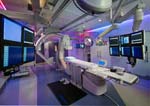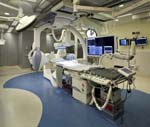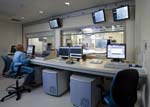
|

|
|
Home Site Search Contact Us Subscribe
|
|
|
INSIGHT: At the Intersection of Medicine, Technology, and Design: Hybrid Operating Rooms Technology has enabled the transformation of classic operating rooms into dynamic, multi-purpose environments - requiring a new design approach for architects. By Ross A. Cole, BAM Architecture Studio December 6, 2011 Learning that you need surgery is never a welcome experience. However, unlike in the past, many patients today have a greater opportunity to select where that surgery takes place.
Patients are more involved in their healthcare choices than ever before and are turning to myriad sources, from healthcare websites to referrals from friends, to determine where to obtain the best treatment. These patients are more highly educated and discerning about medical services and demand more aesthetically-pleasing environments. They realize they have options and aren’t afraid to ask questions.
Hospitals, now in competition for patients and top medical practitioners – and facing increasing financial pressure – are expected to provide the most innovative, efficient, and patient-friendly environments with the most sophisticated healthcare offerings.
The confluence of these factors has made facility upgrades a requirement at medical institutions, not simply an option for healthcare leaders. The result is a plethora of newly renovated facilities and new construction.
Design for Change
Looking at healthcare real estate on a cost-per-square-foot basis, it easily can be argued that operating rooms (ORs) have the most expensive price tags. Simultaneously, ORs are the bedrock of the revenue stream for hospitals. Not surprisingly, therefore, the OR is where some of the biggest bets are being wagered, gained, or lost when it comes to construction.
Advanced technology has converged with conventional approaches to surgery, thus redefining procedures in the OR and allowing medical staff to achieve results nearly inconceivable even a decade ago. It is enabling less invasive procedures, increasing the level of sophistication of what procedures are possible, and shortening patient stays.
To a large degree, diagnostic imaging has evolved from a distinct department with its own location to an activity that takes place in the operating room. Diagnostic imaging in the OR allows surgeons to work faster and more concisely. Equipment once used strictly in a lab is being designed for the OR, and imaging technicians are being taught to function in concert with the surgeon, anesthesiologist, and other members of the OR team. The result is a hybrid operating room (hybrid OR).
Achieving the transition from conventional to hybrid OR requires a careful consideration of several factors. For example, there are many more team members and additional equipment in the OR and it is much more dynamic than conventional equipment. It moves!
When designing a conventional OR, one must consider the movement of carts and perhaps a few medical gas or small equipment booms (booms usually hang from the ceiling and often can move in a radius of a few feet). However, one piece of equipment in a hybrid OR can be the size of a small car and function like a large robot. This equipment, usually five to 15 times the size of an X-ray machine, must then be shoe-horned into a space that still requires the carts and booms of a conventional OR.
Adding to the design challenge, that large piece of equipment moves in myriad directions, and it needs to retract to enable “loading” the patient into the room, onto the operating table, and back out of the room.
The equipment also needs to be designed to fit into the OR without compromising infection control. Additional apparatus must be plugged into outlets in and around the operating table.
Furthermore, the machinery comes with very large monitors, often linked together, that take up space. Those monitors typically need to be brought in close to the table for the surgeon to successfully access the patient. Lastly, this equipment is connected by extensive wiring, which has to be neatly tucked away.
The architect must orchestrate this operating theater, ensuring that all medical staff (doctors, nurses, anesthesiologists, etc.) can move about freely and with ease, thus reducing the possibility of a medical error. The equipment and medical team requires flexibility of movement in order to meet the needs of their patients. It is essential that that the equipment can be reconfigured quickly and easily, so that the medical staff can best access the patient.
A New Design Approach
Clearly, hybrid operating rooms require a new design approach for architects. The static environment of a conventional OR, where the anesthesia cart, medical gas boom, heart pump, surgical light, etc. were specifically placed, is becoming archaic.
To communicate the new design to medical staff, BIM or other forms of 3D modeling are critical. The medical staff needs to understand what they are approving to be built, how it will impact their work, and the effect it will have on the patient.
Although the space’s functionality is critical, the room’s appearance to the patient is also of utmost importance for success. Hybrid ORs must be aesthetically pleasing – calming, well-lit environments that welcome, not intimidate, patients. Instead of using harsh, bright lights, new technologies such as LED lighting allow patients (or physicians) to select what wall wash color they’d like to see during their procedure, giving a sense of control over their environment.
Technology has enabled the transformation of classic operating rooms into dynamic, multi-purpose environments that improve the patient experience, enhance opportunities for physicians, and alleviate many of the financial pressures affecting medical institutions throughout the country. By introducing hybrid ORs, hospitals can plan for more surgeries, expedite patient releases, and attract patients by providing an experience that far exceeds past expectations.
Ross A. Cole, RA, AIA, IFMA, is a co-founder and a principal of New York City-based BAM Architecture Studio. Founded in 2000 and with offices in New York City and Durham, North Carolina, the firm specializes in strategically solving space problems for healthcare, research and corporate clients. |
(click on pictures to enlarge)  Jim Fiora Studio Yale New Haven Hospital, Pediatric Cath Lab, Class C Operating Room  Jim Fiora Studio Yale New Haven Hospital, Pediatric Cath Lab, Control Room  Jim Fiora Studio Yale New Haven Hospital, Electrophysiology (EP) Lab, Class C Operating Room  Jim Fiora Studio Yale New Haven Hospital, Electrophysiology (EP) Lab, Control Room |
© 2011 ArchNewsNow.com